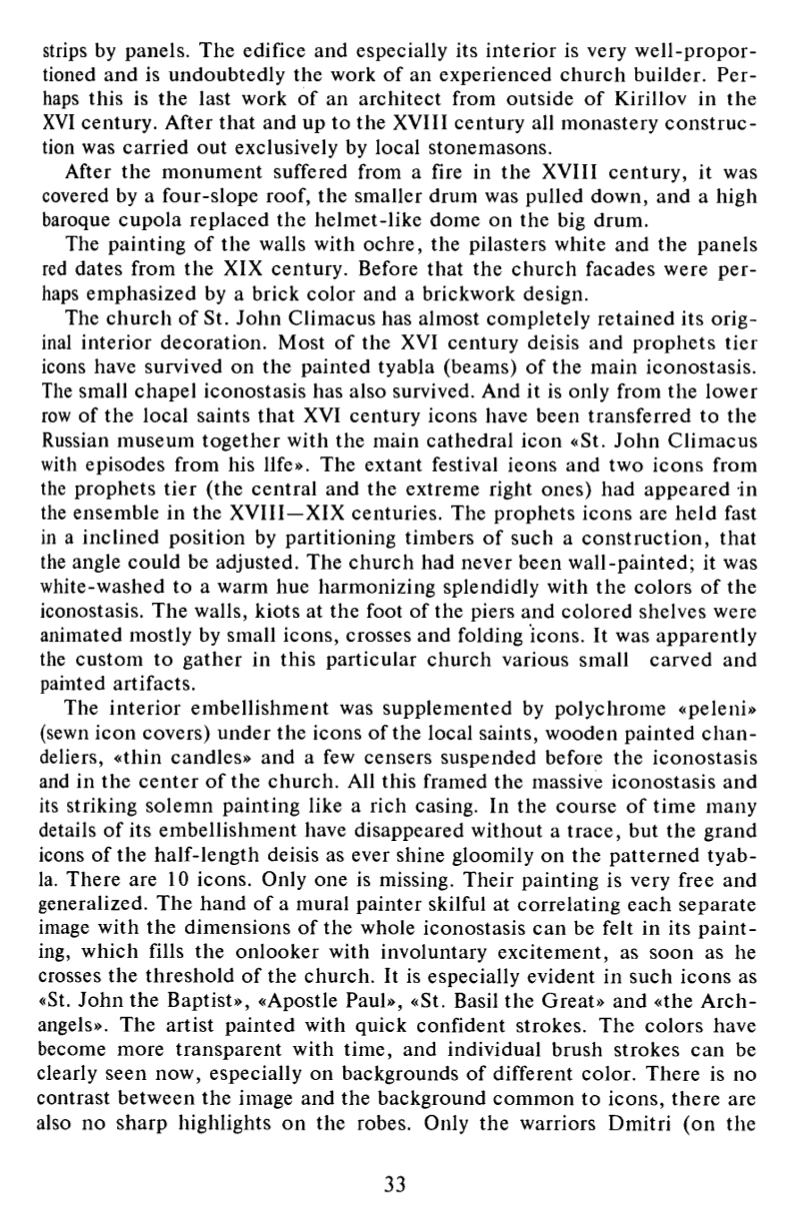

strips by panels. The edifice and especially its interior is very we ll-p ropo r
tioned and is undoubtedly the work of an experienced chu rch builder. Pe r
haps this is the last work of an architect from outside o f Kirillov in the
XVI century. After that and up to the XVIII century all monastery con s tru c
tion was carried out exclusively by local stonemasons.
After the monumen t suffered from a fire in the XVIII century, it was
covered by a four-slope roof, the smaller drum was pulled down, and a high
baroque cupola replaced the helmet-like dome on the big drum.
The painting of the walls with ochre, the pilasters white and the panels
red dates from the XIX century. Before that the church facades were p e r
haps emphasized by a brick color and a brickwork design.
The chu rch of St. John Climacus has almost completely retained its orig
inal interior decoration. Most of the XVI century deisis and p rophets tier
icons have survived on the painted tyabla (beams) of the main iconostasis.
The small chapel iconostasis has also survived. And it is only from the lower
row of the local saints that XVI century icons have been transferred to the
Russian museum together with the main cathedral icon «St. John Climacus
with episodes from his life». The extant festival ieons and two icons from
the prophets tier (the central and the extreme right ones) had appeared in
the ensemble in the XVIII—XIX centuries. The prophets icons are he ld fast
in a inclined position by partitioning timbers o f such a construc tion , that
the angle could be adjusted. The church had never been wall-painted; it was
white-washed to a warm hue harmonizing splendidly with the colors of the
iconostasis. The walls, kiots at the foot of the piers and colored shelves were
animated mostly by small icons, crosses and folding icons. It was apparently
the custom to gather in this particular church various small carved and
painted artifacts.
The in terior embellishment was supplemented by polychrome «peleni»
(sewn icon covers) under the icons of the local saints, wooden painted c h a n
deliers, «thin candles» and a few censers suspended before the iconostasis
and in the cen te r o f the church. All this framed the massive iconostasis and
its striking solemn painting like a rich casing. In the course o f time many
details of its embellishment have disappeared without a trace, but the grand
icons of the half-length deisis as ever shine gloomily on the pa tterned tyab
la. There are 10 icons. Only one is missing. Their painting is very free and
generalized. The hand of a mural painter skilful at correlating each separate
image with the dimensions of the whole iconostasis can be felt in its p a in t
ing, which fills the onlooker with involuntary excitement, as soon as he
crosses the threshold of the church. It is especially evident in such icons as
«St. John the Baptist», «Apostle Paul», «St. Basil the Great» and «the A rch
angels». The artist painted with quick confident strokes. The colors have
become more transparent with time, and individual brush strokes can be
clearly seen now, especially on backgrounds of different color. There is no
contrast between the image and the background common to icons, there are
also no sharp highlights on the robes. Only the warriors Dmitri (on the
33















